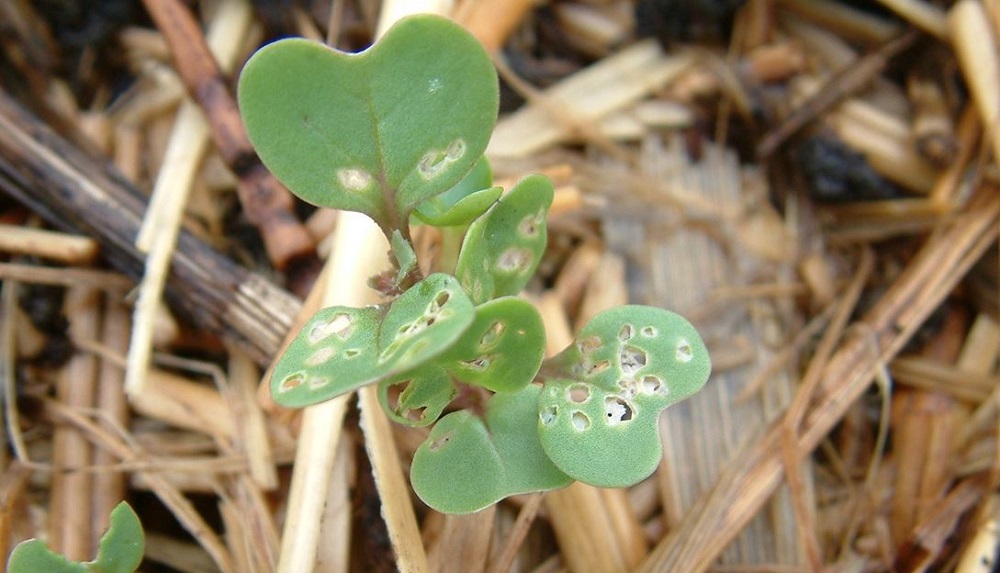- Home
- Knowledge library
- Cabbage stem flea beetle (CSFB) treatment thresholds in oilseed rape
Cabbage stem flea beetle (CSFB) treatment thresholds in oilseed rape
It is essential to target – even avoid – sprays as much as possible, especially as cabbage stem flea beetle (CSFB) has developed resistance to pyrethroid insecticides. It’s why an understanding of field-level pest pressure is at the heart of our spray-threshold system.
Chemical options for CSFB control
Foliar-applied pyrethroid insecticides are the only chemical control available for CSFB in the UK*. However, resistance (first detected in England in 2014) to this class of chemistry is now widespread. Where resistance frequency in CSFB populations is high, potential control will be relatively low. Always use chemicals as a last resort.
Where a spray is necessary, it is important to follow the treatment thresholds and to apply insecticides at the recommended full field rate.
If a pyrethroid application is not effective – and not due to other factors, such as poor spray coverage – it is likely that the pest population is resistant. In such cases, do not apply further pyrethroids, as this will continue to select for resistance and harm natural enemies.
*Alternative active ingredients are on the market for other crops (e.g. cyantraniliprole) but only provide moderate control and are relatively expensive (compared with pyrethroids).
Spray thresholds for CSFB adults
For an early indication of pest pressure, check for CSFB in harvested seed and shot-holing symptoms on volunteer oilseed rape. Monitor for pest damage as soon as crops emerge. The amount of leaf area eaten by beetles, in addition to the growth rate of the plant, can determine the need for treatment.
During germination and emergence (growth stages 1–9), oilseed rape is particularly vulnerable to pest damage. Consequently, consider a treatment at the first sign of attack. After the cotyledons have unfolded (growth stage 10), the crop is far more tolerant to attack. The thresholds are conservative (see table) and the crop potentially may be able to tolerate greater leaf loss, before economic performance is affected.
Classic shot-holing symptoms on oilseed rape
 AHDB
AHDB
Spray thresholds for CSFB larvae
Compared with adult feeding, larval feeding has the potential to be more economically harmful. This is due to the level of investment already made in the crop and the reduction in alternative cropping options (when crops are abandoned).
However, our research shows that crops have high potential to tolerate larval feeding damage. Only 4/36 (11%) experimental datasets (2020 study) showed that increased larval numbers decreased yield. However, in this limited number of situations, yield decreased by between 0.05 and 0.07 t/ha for each additional larvae per plant. These observations are in line with other studies.
CSFB larvae monitoring: The use of yellow water traps
Obtain an indirect measurement of larval populations by counting beetles. Set two yellow water traps on the headland and two in the field, along a wheeling in early September. Fill them with water and a drop of detergent. Empty and reset the traps weekly, recording the number of beetles and adding it to the previous total for that trap. Remove the traps at the end of October. Use the total number of beetles caught in each trap over the full monitoring period to calculate an average number of beetles/trap.
CSFB larvae monitoring: Plant assessment and dissection
Obtain a direct measurement of larvae from a random sample of 25 plants in late October/early November, with plant dissections preferably conducted by an accredited laboratory. Recent results suggest that autumn larval assessments (as opposed to spring assessments) remain the most important, in terms of treatment decisions. Autumn larvae are the most damaging, as they consume plant material for longer – including when the crop is smaller and more vulnerable. Winter and spring larval invasion is likely to be less significant. During any assessment period, CSFB larvae are far more likely to be present in leaf petioles than the stem.
Spray thresholds for CSFB
|
Oilseed rape growth stage (GS) |
Adults |
Larvae |
|||
|
Principal growth stage |
Secondary growth stage (GS) |
Leaf damage (direct) |
Yellow water traps (indirect) |
Plant assessment (indirect) and dissection (direct) |
|
| Germination and emergence | GS05 | Radicle emerged from seed | |||
| GS07 | Hypocotyl with cotyledons emerged from seed | If risk is high, consider treatment at the first sign of attack | |||
| GS08 | Hypocotyl with cotyledons growing towards soil surface | ||||
| GS09 | Cotyledons emerging from soil | ||||
| Leaf development | GS10 | Cotyledons unfolded |
If over 25% of leaf area has been consumed or the crop is growing more slowly than it is being eaten, consider treatment |
Set up traps | |
| GS11 | First leaf unfolded |
Check traps weekly If the average number of adults/trap exceeds 100, consider treatment Remove traps at the end of October |
|||
| GS12 | 2 leaves unfolded | ||||
| GS13 | 3 leaves unfolded |
If over 50% of the leaf area has been consumed or if the crop is growing more slowly than it is being eaten, consider treatment |
|||
| GS14 | 4 leaves unfolded |
Inspect plants in late October/early November If more than 50% of petioles are damaged or there are more than five larvae/plant, consider treatment |
|||
| GS15 | 5 leaves unfolded | ||||
| GS19 | 9 or more leaves unfolded | ||||
| Side-shoot formation | GS21 | 1 side shoot detectable | |||
| GS25 | 5 side shoots detectable | ||||
| GS29 | 9 or more side shoots detectable | ||||
Topics:
Sectors:
Tags:

